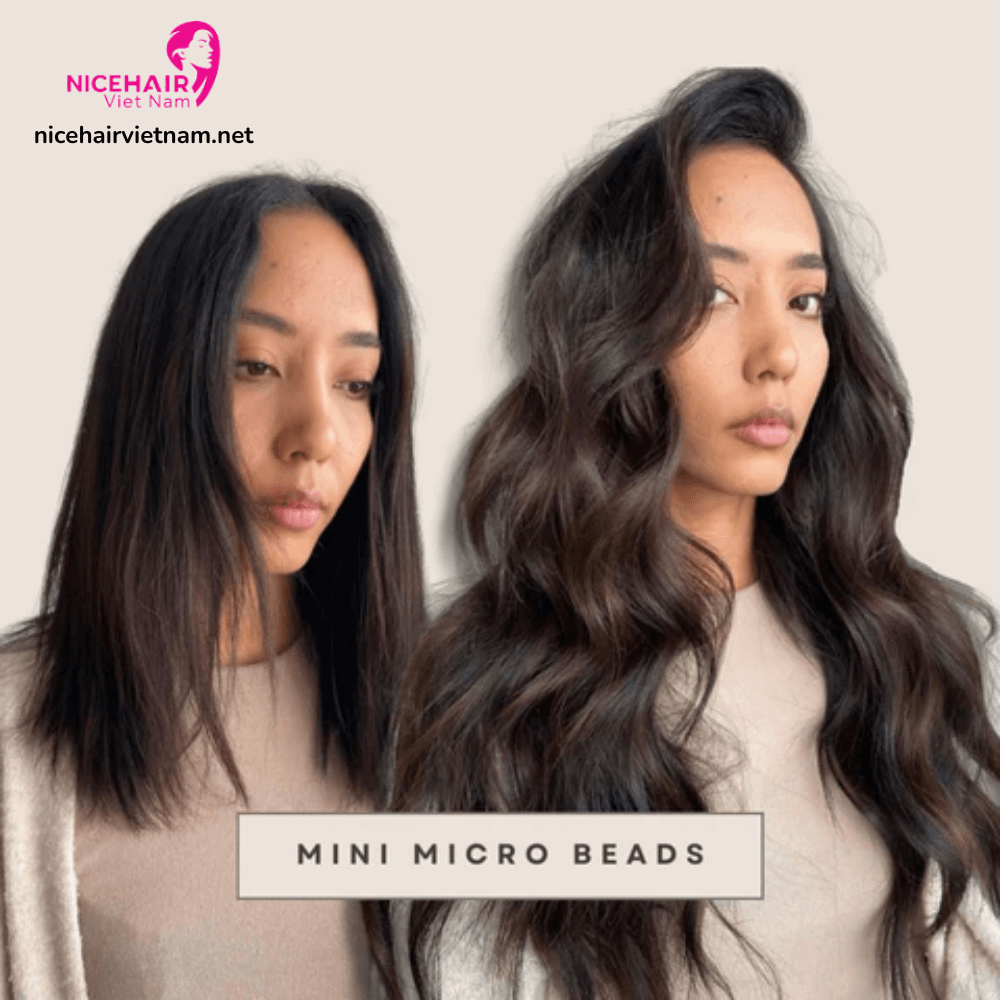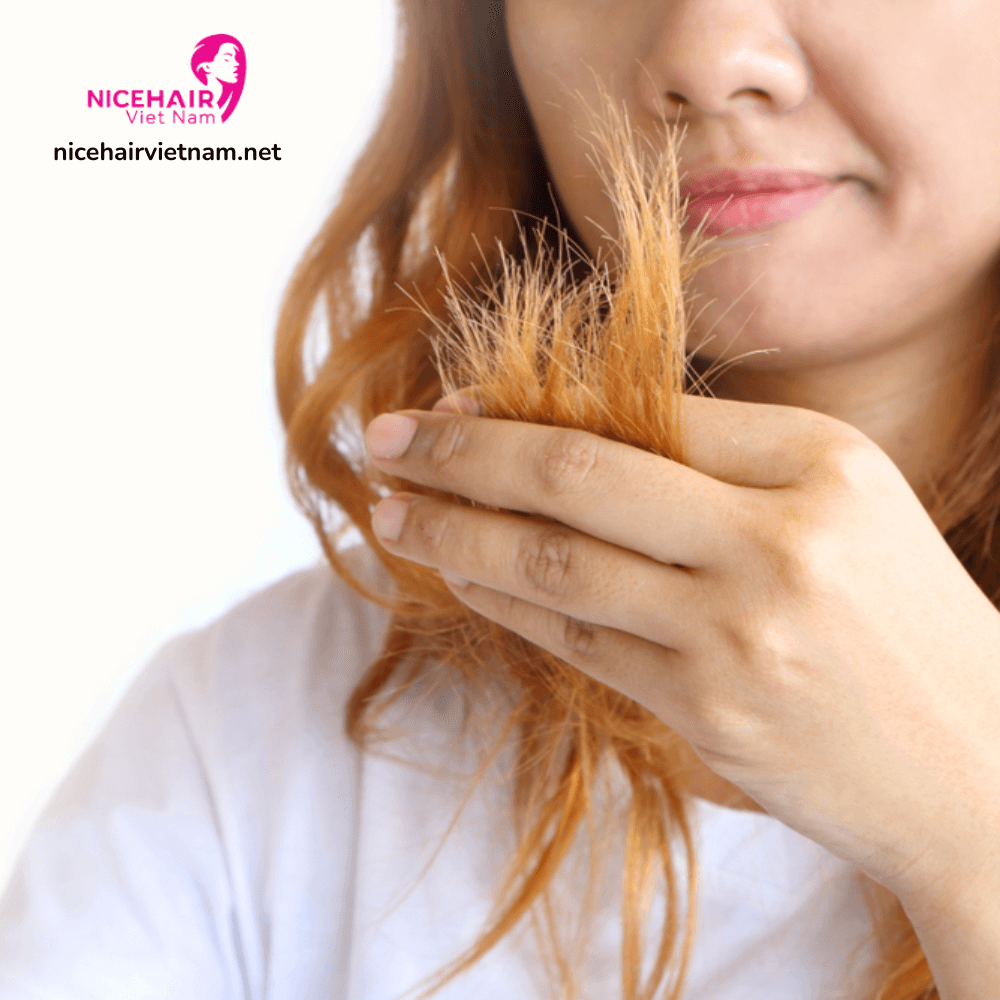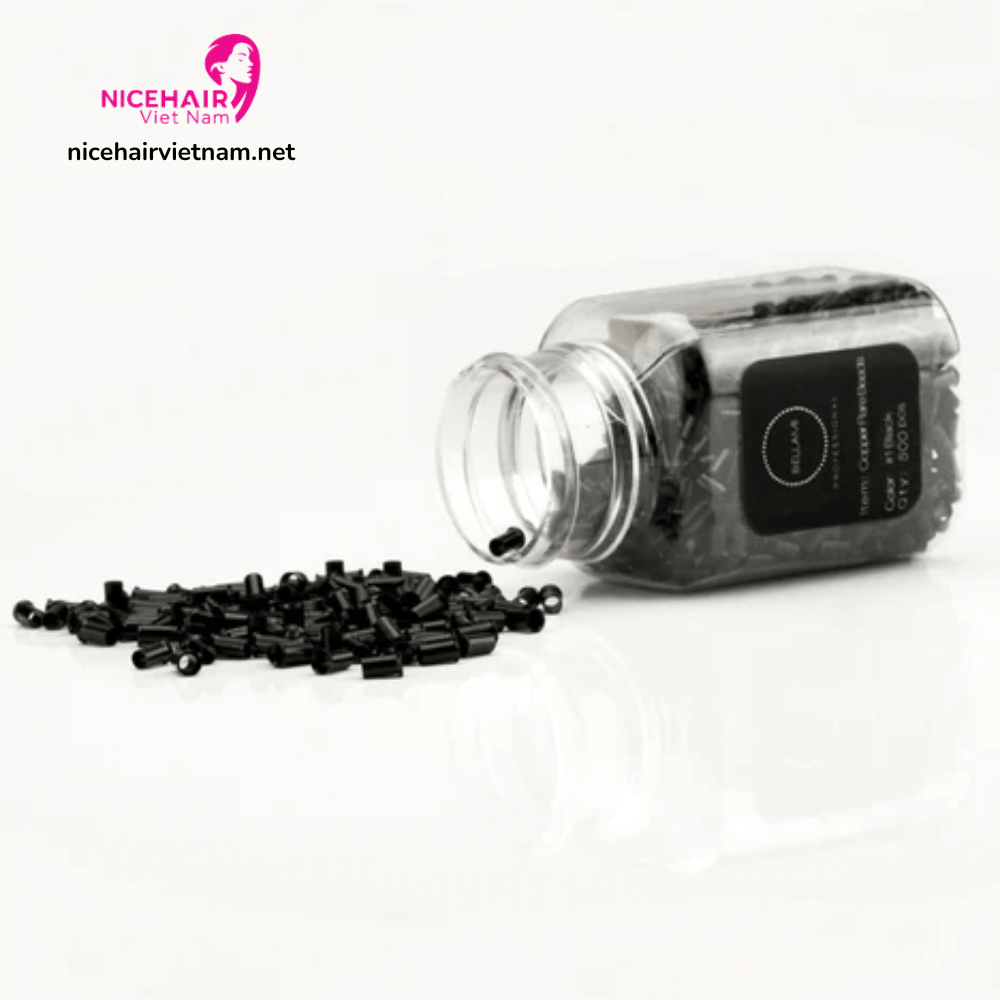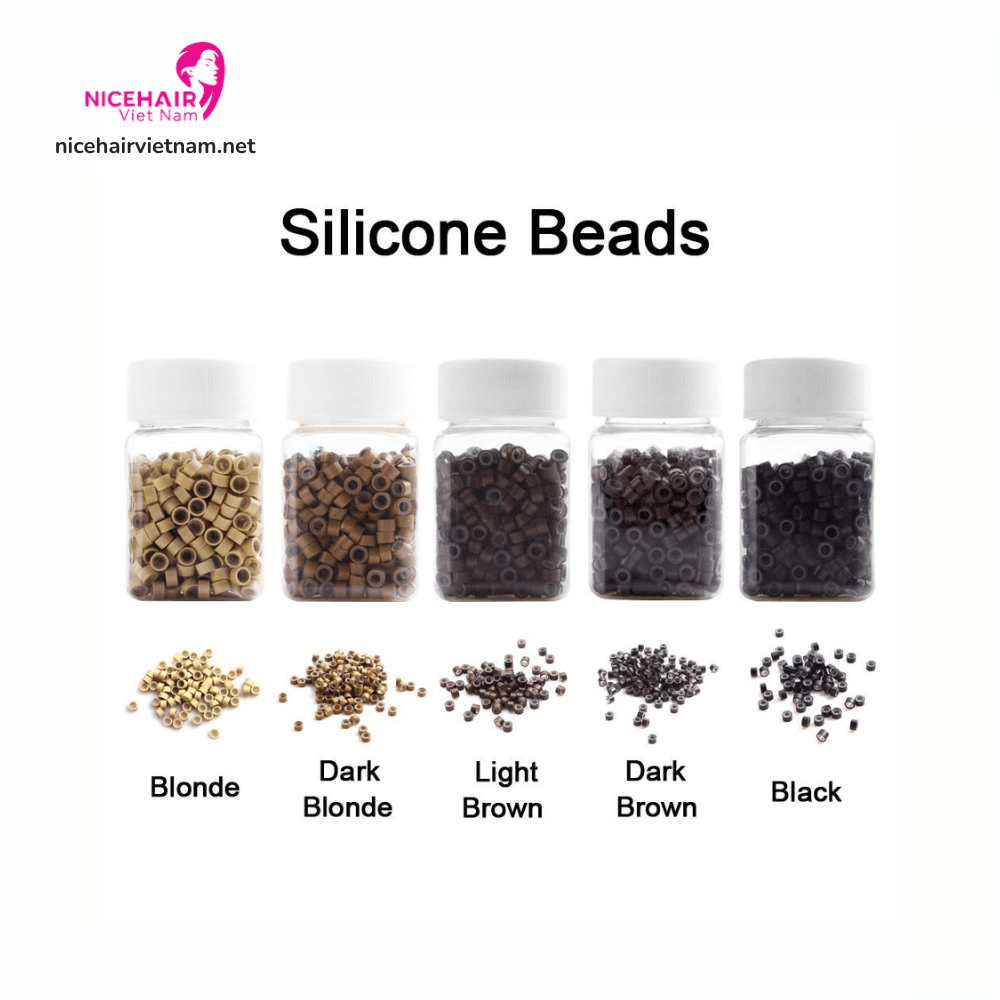Hair extensions can be a great option to transform your current hair into a more gorgeous stunning version with convenience and versatile ability for almost any other hairstyling if you want to apply after that (such as curling, straightening or even adding more colors,…). And microbead hair extensions is definitely also a good choice you may consider, especially for those who demand to add more length, volume to your current hair but still ensure a natural appearance.
However, before having your hair done with this type of hair extensions, you should consider as many aspects of this method as possible. And this post is going to reveal an overview with potential damages and prevention of microbead hair extensions so that you can prepare best for the journey of beautifying your hair and achieve the most positive outcomes from this hair extensions type.

Overview of microbead hair extensions
What is microbead hair extensions?
Terminology
A microbead hair extension, also known as an I-tip hair extension, micro ring, or micro loop hair extension, has gained widespread recognition and remains one of the most sought-after methods for adding length and volume to one’s hair. This technique has withstood the test of time, preserving its immense popularity among hair enthusiasts. The reason behind its enduring acclaim lies in its extraordinary ability to seamlessly blend with natural hair, creating an effortlessly natural appearance. When applied with expertise, these extensions become virtually indistinguishable, allowing individuals to enjoy the benefits of added hair without compromising the overall aesthetic they desire.
Components
Despite each individual microbead hair extension typically containing just around one gram of hair, the transformative power they possess when applied in larger quantities is truly remarkable, resulting in stunning transformations.
To delve into more detail, the effectiveness of microbead hair extensions can be attributed to the main component that lends its name to this extension type – the microbead. A microbead is a small ring, usually made of metal or plastic material, meticulously designed to securely hold hair extensions in place. When applying microbead hair extensions, each pack typically contains approximately 20-25 strands of hair, accompanied by a distinctive feature known as the shoelace link. The shoelace link refers to the tip of each hair strand, where a small loop resembling a shoelace is intricately attached. This loop serves as the point of connection between the hair strand and the microbead during the application process.
The application procedure involves carefully threading the loop through the microbead and then firmly clamping the bead onto the natural hair, ensuring a secure and reliable attachment of the hair extension. This meticulous technique guarantees a natural and seamless blend with the wearer’s own hair. Notably, the shoelace link plays a crucial role in the overall stability and longevity of microbead hair extensions. It serves as the anchor point, as it is securely clamped into the microbead, creating a strong attachment between the extension and the natural hair, ensuring durability and a flawless appearance.
How they apply microbead hair extensions?

This detailed procedure guide will walk you through the step-by-step process of applying microbead hair extensions.
- Consultation and preparation: Before beginning the application process, it is crucial to have a consultation with a professional hair extension specialist. During this consultation, you can discuss your desired outcome, hair color, texture, and the number of extensions needed. The specialist will also assess the condition of your natural hair and scalp to ensure it is suitable for the application.
- Hair preparation: To prepare your hair for the extensions, it is important to wash and dry it thoroughly. Avoid using any conditioning products or serums that may leave residue, as this can affect the bond between your natural hair and the extensions. It is recommended to brush your hair to remove any tangles or knots.
- Sectioning the hair: Divide your hair into small sections using hair clips or hair ties. Start at the nape of your neck and work your way up to the crown of your head. This will help you apply the extensions systematically and ensure an even distribution.
- Selecting the extensions: Choose the appropriate color and length of hair extensions that match your natural hair. Each microbead hair extension typically contains around one gram of hair. The extensions come in various lengths, ranging from 14 to 24 inches, allowing you to achieve your desired look.
- Applying the extensions: Take a small section of your natural hair from the bottom layer and insert a pulling needle or threading wire through the microbead. Then, thread the shoelace link of the extension through the needle or wire. Gently pull the needle or wire back through the microbead, sliding the extension into place. Ensure the extension is securely in the microbead, close to the scalp.
- Securing the extensions: Once the extension is in place, use a pair of flat pliers or hair extension pliers to clamp the microbead tightly. This will securely hold the extension and create a strong bond with your natural hair. It is essential to be cautious during this step to avoid applying excessive pressure that could damage your hair or cause discomfort.
- Repeat the process: Continue sectioning your hair and repeating steps 5 and 6 until you have applied all the desired extensions. Ensure that the extensions are evenly distributed and blended with your natural hair. Remember to leave some space around the hairline to maintain a natural-looking result.
- Blending and styling: Once all the extensions are in place, carefully comb through your hair to blend the extensions with your natural hair. Style your hair as desired, keeping in mind that microbead hair extensions can be curled, straightened, and even colored, just like your natural hair. Take caution with heat styling tools to prevent damage to the extensions.
- Aftercare: To maintain the longevity and appearance of your microbead hair extensions, it is important to follow proper aftercare. Avoid excessive heat exposure, use gentle hair care products specifically formulated for extensions, and brush your hair regularly using a loop brush or extension-friendly brush to prevent tangling.
- Maintenance and removal: Microbead hair extensions typically last for several months, depending on your natural hair growth and maintenance routine. As your hair grows, the extensions will gradually move away from the scalp. Regular maintenance appointments with a professional are recommended to adjust and reposition the extensions. When it’s time to remove the extensions, a professional should carefully unclamp the microbeads, allowing the extensions to slide out without causing damage to your natural hair.
Is microbead hair extensions safe?
Microbead hair extensions are generally considered to be a safe and reliable method of hair extension compared to other types. Unlike methods that involve the use of heat, glue, or chemicals, microbead extensions do not require any harsh substances or tools that can potentially damage the hair or scalp.
One of the main advantages of microbead hair extensions is that they offer a non-invasive application process. The extensions are attached to the natural hair using small metal or plastic rings, known as microbeads, which are clamped onto the hair strands.
Furthermore, microbead hair extensions do not interfere with the natural growth cycle of the hair. They allow the hair to move and breathe freely, minimizing the risk of traction alopecia or damage to the hair follicles. This makes microbead extensions a suitable option for individuals who prioritize hair health and want to avoid potential long-term damage. However, it is not really recommended for too short, thin and greatly damaged hair because of certain potential risks during the installation or removal process.
Is microbead hair extensions damage real?
Yes, damage can occur with microbead hair extensions, although they are generally considered a relatively safe and damage-free hair extension method. While microbead hair extensions are typically made from human hair and do not involve the use of heat, glue, or chemicals, there are still potential risks.
Microbead hair extensions damage can occur during the installation or removal process if not done carefully or properly. During installation, if excessive pressure is applied to the hair or if the beads are placed too close to the hair roots, it can lead to breakage or hair loss. Similarly, when removing the extensions, using pliers or tools without caution can result in cutting or damaging the natural hair.
Poor quality products can also contribute to damage, such as thinning or weakening of the hair. Low-quality extensions may not be durable or may irritate the scalp, causing discomfort or potential damage.
It is important to note that while damage can occur, it is generally mild and uncommon, happening in only a few cases where proper care is not taken. Microbead hair extensions are still considered a relatively safe option. However, it is not recommended for too thin or short as well as greatly damaged hair. To minimize the risk of damage, it is advisable to purchase high-quality hair extensions from reputable sources and ensure that the installation and removal processes are done by a skilled professional or following proper guidelines.
Popular microbead hair extensions damages
In addition to the microbead hair extensions damage which has just been mentioned in the previous section, there are also other factors that can cause damage. The following section is about to introduce several other reasons that you should take notice of.
Weak hair

This is a common issue that microbead hair extensions users may encounter. While using these extensions, there is a possibility of them falling out, tangling, or becoming entangled with the natural hair. Furthermore, improper installation or removal of microbead extensions can result in damage to your natural hair. If the beads are clamped too tightly or if the removal process is too forceful, it can lead to hair breakage, thinning, or even bald patches. It is important to note that not only the hair extensions but also the real hair may be affected and can potentially fall out. Additionally, applying microbead extensions to wet hair can weaken the strands and make them more prone to falling off.
Besides, improper brushing techniques, excessive heat styling, or neglecting to detangle the extensions regularly.When microbead hair extensions become tangled or matted, it can be difficult to manage and style the hair effectively. The extensions may intertwine with the natural hair or get caught in knots, leading to a messy and unkempt appearance. This can be frustrating and time-consuming to deal with, potentially impacting your overall hair care routine.
To mitigate these risks, it is crucial to seek professional assistance or carefully follow detailed instructions when applying or removing the extensions. Furthermore, extended use of microbead hair extensions can weaken the hairline as it is continuously pulled down. Proper maintenance and regular care are essential to prevent further damage. It is advisable to avoid using this type of hair extension for prolonged periods or while sleeping to minimize the potential damage that can occur. By being mindful of these factors and taking appropriate measures, you can help prevent the occurrence of damage associated with microbead hair extensions.
Uncomfortable scalp

Microbead hair extensions involve attaching small beads directly to the hair, which can create pressure on the scalp and cause discomfort. Placing the beads too close to the scalp can make them feel heavy, further adding to the discomfort. Prolonged use of microbead extensions may even lead to mild headaches or fatigue due to the constant pressure exerted on the scalp.
Furthermore, it is essential to be aware of potential damage caused by low-quality hair extensions. Even if the beads do not directly contact the scalp, some individuals may experience scalp irritation or sensitivity due to the presence of the beads and the weight of the extensions. This can result in itchiness, redness, or general discomfort. Additionally, there is a risk of developing allergies to the materials used in the extensions, which can lead to further complications. If you have a sensitive scalp or existing scalp conditions, it is advisable to consult with a hairstylist or dermatologist before considering the use of microbead extensions.
Taking these factors into account, it is important to carefully assess your scalp’s sensitivity and overall comfort before opting for microbead hair extensions. By consulting professionals and opting for high-quality extensions, you can minimize the potential for discomfort, irritation, and other associated risks.
Material allergic
When using microbead hair extensions, it is possible for some individuals to experience allergic reactions to the materials used in the extensions. While these reactions are not common, it is essential to be aware of the potential allergens and take necessary precautions. Here are some materials that could potentially cause allergic reactions:
- Metal allergies: Microbeads are often made of metal, such as aluminum, copper, or stainless steel. Nickel, a common component in metal alloys, is a known allergen for some individuals. Allergic reactions to nickel can range from mild irritation and redness to more severe symptoms like itching, swelling, and even blistering. If you have a known allergy to metal or specifically to nickel, it is crucial to choose microbead hair extensions that are nickel-free or made from hypoallergenic metals.

- Silicone allergies: Some microbead hair extensions use silicone-lined beads to protect the hair and provide a secure attachment. While silicone allergies are relatively rare, they can occur in individuals who are sensitive to silicone-based materials. Symptoms of a silicone allergy may include redness, itching, swelling, or a rash on the scalp or skin where the extensions are attached. If you have a known silicone allergy, it is advisable to opt for extensions that do not contain silicone or consult with a dermatologist or allergist before using them.

Allergies can develop over time or may already exist, even if you have not experienced a reaction in the past. While these materials are generally well-tolerated by most individuals, it is important to note that some people may have allergies or sensitivities to them.To minimize the risk of allergic reactions, it is recommended to check the composition of the microbead hair extensions before application. By performing a patch test, and seeking professional advice, you can reduce the likelihood of experiencing allergic symptoms and enjoy the benefits of microbead hair extensions without compromising your health.
How to prevent microbead hair extensions damage

It’s important to note that many of these risks can be minimized or avoided with proper application, professional assistance, and diligent maintenance. Consulting a hairstylist experienced in microbead extensions and following their guidance can help mitigate potential risks and ensure a safe and satisfactory experience.
Proper treatment and care of microbead hair extensions are essential to maintain their appearance and longevity. Here are some tips on how to treat and care for your microbead hair extensions:
- Buy products from a reputable supplier: It is crucial to exercise caution when dealing with counterfeit or unscrupulous manufacturers who may offer substandard products or extensions made from synthetic materials rather than real human hair. These low-quality alternatives can result in discomfort or even allergic reactions. To avoid such issues, it is imperative to conduct thorough research and only make a purchase once you have determined the supplier’s credibility and reliability.
- Choose carefully the type of microbead hair extensions: Consider factors such as the desired length, weight, volume, and color to ensure a comfortable fit that doesn’t exert excessive pressure on your natural hair. By choosing extensions that align with your preferences and hair characteristics, you can minimize the potential for damage caused by microbeads.
- Learn about the microbead hair extensions tutorials for proper use: Familiarize yourself with tutorials and instructional materials that provide guidance on how to correctly install and remove the extensions. Pay close attention to the step-by-step instructions and any accompanying notes to ensure a smooth and successful application. It is vital to exercise caution and avoid mistakes during the process, as errors in installation, removal, or general carelessness can result in hair loss. Online platforms like YouTube or search engines like Google offer a wealth of helpful resources that provide detailed instructions for your reference.
- Take care of microbead hair extensions regularly: Utilize specialized hair extension products such as shampoo, conditioner, and masks to provide adequate care. These products are designed to nourish and protect the extensions, promoting softer and stronger hair that is less prone to breakage. By incorporating a proper care routine and following the recommended guidelines, you can significantly reduce the likelihood of microbead hair extensions damage.
- Be mindful of activities: When participating in activities that may strain or pull on your hair, such as swimming, exercise, or contact sports, consider tying your hair back or wearing a protective style. This will help minimize stress on the extensions and reduce the risk of damage or bead slippage.
- Avoid heat damage: Excessive heat can damage both your natural hair and the extensions. Minimize the use of heat styling tools such as straighteners, curling irons, and blow dryers. If heat styling is necessary, use a heat protectant spray and set the tools to a low or medium temperature.
- Secure during sleep: Before going to bed, tie your hair in a loose braid or ponytail to prevent tangling and matting. Consider using a silk or satin pillowcase or a hair bonnet to minimize friction and protect the extensions while you sleep.
- Avoid harsh chemicals: Avoid using products containing harsh chemicals, such as alcohol-based styling products or hair sprays, near the bonds. These chemicals can weaken the bonds and cause the extensions to come loose. Opt for extension-friendly styling products instead.
- Professional removal: When it’s time to remove the microbead hair extensions, it’s recommended to visit a professional stylist. They have the expertise to safely remove the extensions without causing damage to your natural hair.
- Regular bead inspection: Periodically check the beads to ensure they are secure and in good condition. If you notice any loose or damaged beads, seek assistance from a professional stylist to have them repaired or replaced promptly.
- Avoid excessive tension and touching: Be mindful of hairstyles that create excessive tension on the extensions, such as tight ponytails or braids. Constant pulling and strain on the bonds can weaken them and cause damage over time. Opt for looser hairstyles that distribute the weight evenly. Besides, minimize excessive touching, twisting, or playing with your extensions. Constant manipulation can cause the beads to loosen or the hair to tangle, leading to potential damage or premature removal.
- Protect from sun and chlorine: Excessive exposure to sunlight and chlorinated water can have damaging effects on your extensions. Before swimming, wet your hair with clean water and apply a leave-in conditioner to create a barrier between the extensions and chlorinated water. Additionally, wear a hat or use a UV-protective spray to shield your hair from the sun’s harmful rays.

